تُعد هندسة البرمجيات مجالاً ديناميكيًا حيث تتدفق المواهب الجديدة كل عام، مما يزيد من حدة المنافسة. بالنسبة للمحترفين في هذا المجال, تحديد الأهداف المهنية هو تمرين ترسيخ - إنه يبقي الدافع مرتفعًا ويرفع من إمكانات الكسب، ويفتح مسارات لأدوار رفيعة المستوى. ومع ذلك، فإن تحديد الأهداف المهنية الصحيحة في مثل هذا المجال المهني الواسع أسهل قولاً من فعله.
ربما تهدف إلى تحقيق البراعة التقنية أو الغوص في الخوارزميات أو إتقان هياكل البيانات. وعلى الجانب الآخر، قد يكون تعزيز مهاراتك في البرمجة من خلال لغة برمجة جديدة على رادارك.
أو ربما أنت تنتمي إلى غالبية مهندسي البرمجيات الذين ليس لديهم فكرة واضحة عن الخطوات التالية في حياتهم المهنية ويقدرون بعض التوجيهات.
في هذه المقالة، سنستكشف في هذه المقالة الأهداف المهنية المختلفة لمهندسي البرمجيات ونقدم نصائح عملية حول تحديدها وتحقيقها بنجاح باستخدام الأدوات المناسبة. دعونا نتعمق في الموضوع!
فوائد وضع أهداف (SMART) لمطوري البرمجيات
إن تحديد الأهداف المهنية كمهندس برمجيات يوجه نموك المهني ويوفر خارطة طريق واضحة للتطور الوظيفي . يتيح لك القيام بذلك التركيز على التعلم وبناء المهارات و إدارة وقتك بكفاءة . كما أنه يبقيك على اطلاع على أحدث اتجاهات التكنولوجيا والذكاء الاصطناعي، ويساعدك في توسيع شبكة علاقاتك، ويعزز مهاراتك التقنية والشخصية، و يزيد من إنتاجيتك .
ولكن من أين تبدأ؟ الإجابة: اتباع إطار العمل الذكي لأهداف مهندسي البرمجيات. يرمز SMART إلى:
- Sخاص
- مقابلة للتحقيق
- مقابلة للتحقيق
- ريغالية
- تممحددة زمنياً
تأكد من أن الأهداف التي تضعها تنطبق عليها هذه المربعات. إذا لم تكن كذلك، فقم بتحليلها بشكل أكبر وقم بتقسيمها إلى خطوات أصغر وأكثر قابلية للإدارة حتى تتوافق مع معايير SMART. يضيف هذا النهج هيكلاً لعملية تحديد أهدافك ويزيد من احتمالية النجاح. 🥇
من خلال السعي لتحقيق تحسين الأداء من خلال تحديد الأهداف الذكية (SMART)، فإنك تفتح الأبواب أمام رسم بياني وظيفي أفضل وإمكانات كسب أفضل. والأهم من ذلك أن تحقيق الأهداف المحددة يجلب الرضا الشخصي ويمكن أن يؤدي إلى أسلوب حياة أكثر إشباعًا.
هل تريد البدء في تحديد أهدافك الهندسية الذكية على الفور؟ استفد من قالب الأهداف الذكية من ClickUp SMART Goals لإنشاء و تتبع جميع أهدافك من خلال قوائم قابلة للتنفيذ. تتيح لك حالاته المخصصة، مثل مكتملة، ومحطمة، وخارج المسار، ومُعلّقة، وعلى المسار الصحيح، وتتبع الأهداف دون عناء!
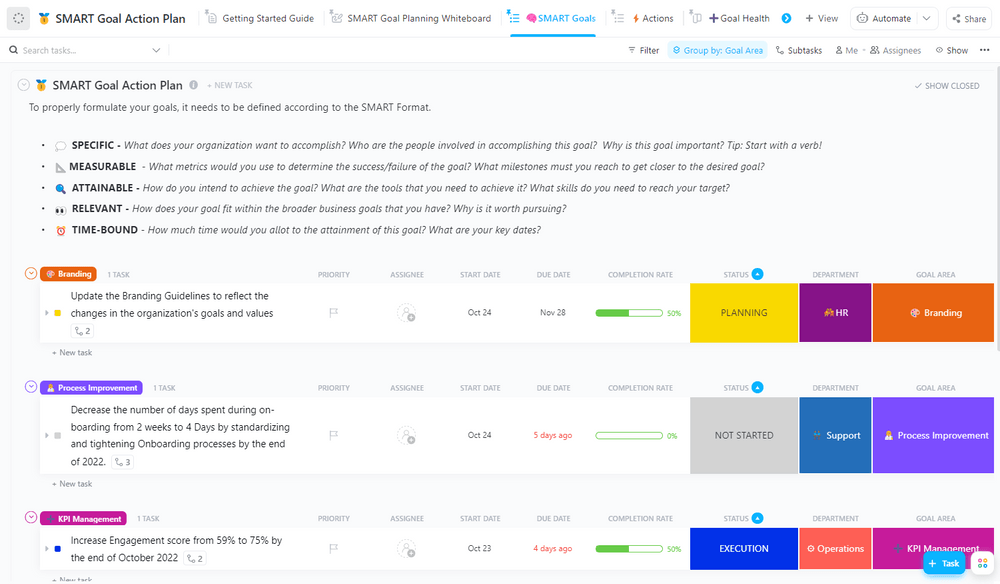
قم بتنظيم جميع أهدافك لتتناسب مع معايير SMART وتتبعها في قوائم يسهل الوصول إليها باستخدام قالب الأهداف الذكية ClickUp SMART Goals Template
/ctaBtn/الأخضر https://app.clickup.com/signup?template=t-222168692 قم بتنزيل هذا القالب /%ctaBtntn/
10 أمثلة على الأهداف ذات القيمة العالية لمطوري البرمجيات
غالبًا ما يبدو اختيار الأهداف المثلى لهندسة البرمجيات لنفسك أو لفريقك أسهل مما هو عليه في الواقع. لمساعدتك في ذلك، سنقدم لك 10 أمثلة على الأهداف الذكية لمهندسي البرمجيات. استخدمها كمصدر إلهام لوضع الأهداف المهنية التي ستوجهك نحو النجاح! 🏆
1. التقنية
الأهداف التقنية تتعلق بتعلمك وتطورك الفردي كمحترف في هندسة البرمجيات. وتشمل هذه الأهداف إتقان هياكل البيانات والخوارزميات وأساسيات الشبكات ومنهجيات الاختبار والتشفير. على سبيل المثال، يمكن أن تتضمن أهداف تطوير مهاراتك التقنية ما يلي:
- تنفيذ وتحسين بنية تحتية سحابية قابلة للتطوير لمشروع ما خلال الأشهر التسعة القادمة
- تطوير ميزة جديدة باستخدام لغة برمجة جديدة أو إطار عمل جديد خلال الأشهر الأربعة القادمة
- أتمتة عملية حرجة داخل الفريق باستخدام البرمجة النصية أو البرمجة البرمجية خلال الأشهر الثلاثة القادمة
إذا كنت تخطط لمبادرات الارتقاء بالمهارات لنفسك أو لفريقك، فاستخدم نموذج مصفوفة ClickUp للمهارات الفنية لقياس مدى تقدم المستخدم! يسمح هيكل المستند المرمز بالألوان بترتيب المهارات من 1 (مبتدئ) إلى 4 (خبير) لتحديد المجالات التي تحتاج إلى مزيد من التركيز والتفاني! 💪

حدد المهارات الفنية التي ترغب في تحسينها وتتبعها باستخدام الحقول المخصصة باستخدام قالب مصفوفة المهارات الفنية ClickUp
/ctaBtn/الأخضر https://app.clickup.com/signup?template=t-205427994 تنزيل هذا القالب /%ctaBtntn/
2. الترميز
تقع البرمجة في صميم ما تقوم به فرق البرمجيات، مما يجعلها واحدة من أهم المهارات التي يجب تطويرها. فيما يلي بعض الأمثلة على الأهداف المتعلقة بالبرمجة:
- خذ الأسابيع الثلاثة القادمة لترتيب قاعدة البرمجة، مما يسهل فهمها وصيانتها
- إدخال خوارزمية جديدة لتحسين جزء مهم من النظام خلال الأسبوعين المقبلين
يمكنك التعمق أكثر في أهداف الترميز من خلال التركيز على الجودة والملكية.
تتمحور أهداف جودة الكود حول تتبع الأخطاء في الكود. على سبيل المثال، يمكنك أن تهدف إلى تقليل عدد الأخطاء الموجودة في التطبيق بنسبة 10% في الشهر التالي.
تشير أهداف *ملكية الكود إلى أن تكون مسؤولاً عن قاعدة التعليمات البرمجية بأكملها. من خلال تولي الملكية الكاملة للرمز البرمجي، يمكن أن يكون هدفك هو ضمان أن تظل المنصة تعمل بنسبة 99.99% من الوقت خلال الأشهر الثلاثة القادمة.
3. تصميم النظام
تدور أهداف تصميم النظام حول تحقيق إنجازات مهمة تؤثر على منتجات أو أنظمة بأكملها. هدفك هو إجراء تغييرات مؤثرة، لذا يجب أن يكون لديك فهم شامل لكيفية عمل النظام وتطوره. إليك بعض الأمثلة:
- العمل على تحسين سرعة استرجاع البيانات بنسبة 30% في الأشهر الستة المقبلة
- العمل كفريق واحد لتصميم وإضافة مجموعة جديدة كاملة من الميزات إلى منتج ما في غضون أربعة أشهر
4. الاختبار
يُعد اختبار البرمجيات جزءًا مهمًا من عملية التطوير، حيث يضمن للفرق التقاط الأخطاء الرئيسية وإصلاحها قبل أن يضع المستخدمون أيديهم على البرنامج. ولكي يكون المهندسون بارعين في الاختبار، يجب أن يمتلكوا قدرات مثل ضمان تغطية اختبارية شاملة وإجراء اختبارات مستهدفة على أجزاء محددة من التعليمات البرمجية.
وتتضمن بعض الأهداف المهنية التي يمكنك تحديدها للتحسن في الاختبار ما يلي:
- بحلول نهاية الربع، حاول أن تجعل 90% من الوظائف الحرجة تحتوي على اختبارات آلية
- في غضون ستة أشهر، قم بإعداد اختبارات لتقييم مدى جودة أداء مسارات المستخدم الرئيسية
5. تصحيح الأخطاء
بمجرد أن يحدد الاختبار الشامل الأخطاء في البرنامج، فإن الخطوة التالية هي حل هذه المشكلات من خلال تصحيح الأخطاء. ومثل أهداف تصميم النظام وأهداف الاختبار، ترتبط أهداف تصحيح الأخطاء إلى حد ما بأهداف البرمجة.
ومع ذلك، فإن أهداف تصحيح الأخطاء الأكثر فعالية لا تركز فقط على الخطأ ولكن أيضًا على تأثير حلها على البرنامج. فيما يلي مثالان:
- قم بإنشاء طرق عرض مخصصة في أداة التسجيل لكل مشروع جديد هذا العام لتسهيلالعثور على المشكلات وإصلاحها
- إتقان استخدام أدوات تصحيح الأخطاء في لغة البرمجة الخاصة بك، وتجاوز مجرد طباعة المعلومات بحلول نهاية الأشهر الثلاثة القادمة لمعالجة المشاكل بشكل أفضل
استكشف كليك أب قوالب مجانية للإبلاغ عن الأخطاء لتمنح نفسك انطلاقة قوية وتبسيط تتبع الأخطاء بالاعتماد على تخطيطات مصممة مسبقًا لتوفير وقتك الثمين! 🕒
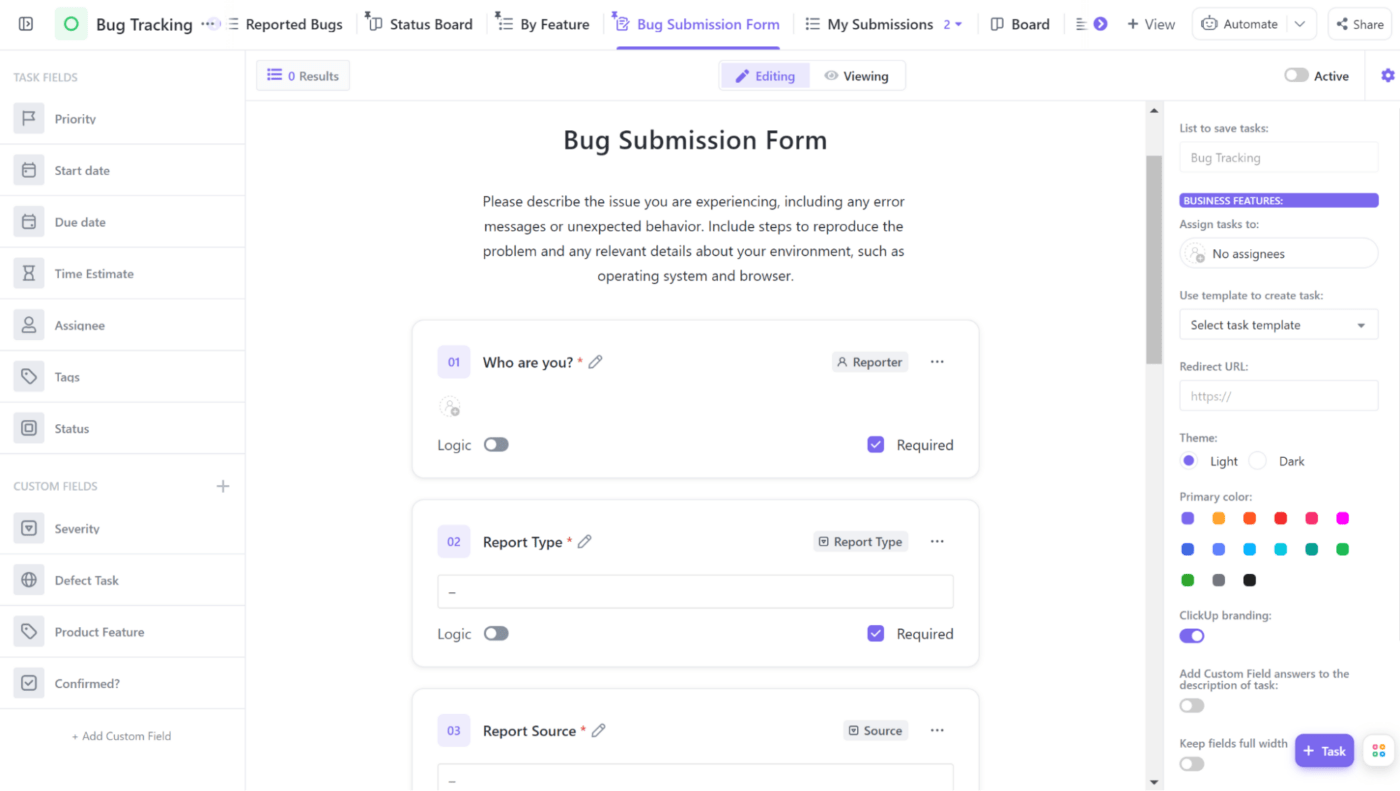
تبسيط الإبلاغ عن الأخطاء باستخدام نموذج قابل للمشاركة بسهولة متوفر في قالب نموذج الإبلاغ عن الأخطاء ClickUp Bug Report Form
/ctaBtn/الأخضر https://app.clickup.com/signup?template=t-240073126 تنزيل هذا القالب /%ctaBtnTn/
6. شخصي
بصرف النظر عن الأهداف التي تركز على الشركة، يجب أن يتمتع مهندس البرمجيات الكفء بما يلي أهداف شخصية أيضًا. تتمحور هذه الأهداف حول الاستفادة من مهاراتك في البرمجة والتواصل لتصبح رائد أعمال أو تعزيز قابليتك للتوظيف من أجل فرص عمل أفضل. قد تتضمن هذه الأهداف
- تعلم لغة برمجة جديدة خلال الأشهر الثلاثة القادمة
- ترتيب اجتماعات شهرية مع خبراء الصناعة للتعلم من خبراتهم ورؤاهم
7. إدارة الفريق
العمل الجماعي القوي و مهارات إدارة الفريق هي أمر حيوي لمهندسي البرمجيات، خاصةً المهنيين رفيعي المستوى الذين يقودون المشاريع. بالإضافة إلى ذلك، إذا كنت ترغب في إدارة عملك الخاص، فأنت بحاجة إلى تعلم كيفية قيادة وتحفيز وإدارة الآخرين بفعالية.
فيما يلي أهداف تهدف إلى تعزيز مهارات إدارة الفريق ومهارات التواصل والتعاون:
- توظيف عضو جديد في فريق الهندسة وتدريبه في غضون ثلاثة أشهر حتى يلبي أداؤه التوقعات
- تولي مسؤولية أحد المشاريع في الربع القادم، وضمان إدارته بشكل جيد وتسليمه في الموعد المحدد
هل تحتاج إلى أداة ملائمة لبدء قيادة فريقك بكفاءة؟ خطط لإدارة الفريق وتتبع أداء الجميع في مكان واحد باستخدام نموذج خطة إدارة فريق ClickUp لإدارة الفريق ! 👥
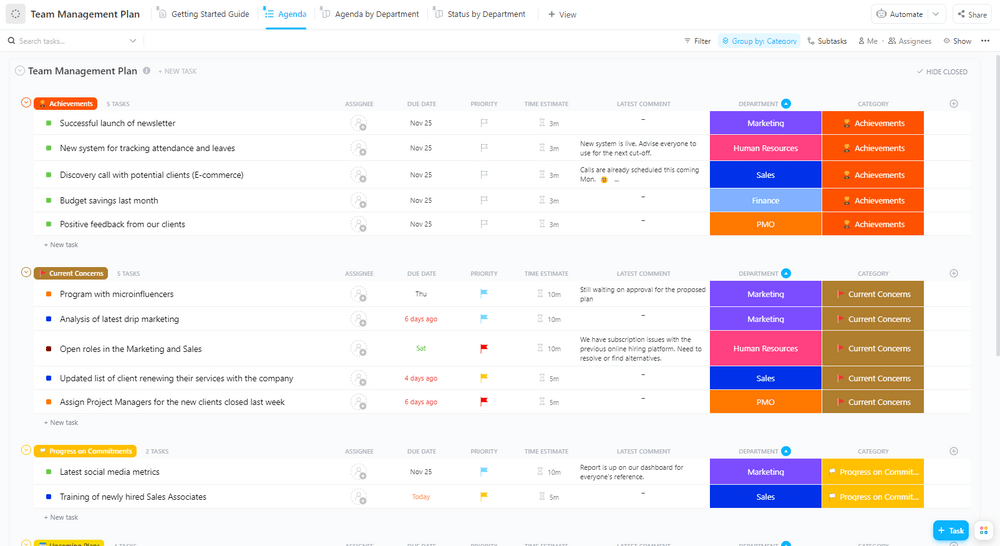
قم بتوصيل الفرق عبر المؤسسة وإدارتها بفعالية باستخدام قالب خطة إدارة فريق ClickUp لإدارة الفرق
/ctaBtn/الأخضر https://app.clickup.com/signup?template=t-211294139 تنزيل هذا القالب /%ctaBtntn/
8. العمل الجماعي
إن كونك لاعبًا جماعيًا هو هدف ممتاز يجب أن تتحلى به لأنه يمكن أن يساعدك على أن تبدو مرغوبًا لدى أصحاب العمل المحتملين. وهو لا يعني فقط التوافق في العمل الجماعي - بل يعني تعزيز الجودة الشاملة لمشاريع البرمجيات وعروض العملاء بجهد جماعي. التواصل القوي والعمل الجماعي تبسيط العمليات وتحسين النتائج من خلال الخبرات المشتركة ووجهات النظر المتنوعة.
من أجل تحسين شهيتك للتعاون يمكنك
- بشكل تعاونيإنشاء تقنية تقييم البرامج ومراجعتها (PERT) أو مخططات جانت لتوضيح دور الجميع
- قم باستضافة وقيادة اجتماعات منتظمة، سواء كانت يومية أو أسبوعية، لتقليل التعارضات ومعرفة كيف يمكنك المساهمة في الصورة الأكبر استفد منتكامل ClickUp Zoom لجلسات أكثر إنتاجية
9. التواصل الشبكي
حتى لو كنت تشعر أن جهاز الكمبيوتر الخاص بك هو أقرب رفيق لك في هندسة البرمجيات، فإن التواصل وجهاً لوجه لا يزال مهماً. فالتواصل مع الأقران في مجال عملك ضروري بشكل خاص إذا كان هدفك هو عرض فكرة جديدة أو العثور على متعاون، مثل مهندس برمجيات كبير، يمكنه المساعدة في تحسين منتجاتك أو تسريع الجدول الزمني للتطوير. لتوسيع شبكة علاقاتك، يجب عليك
- جدولة لقاءات مع كبار مهندسي البرمجيات من فرق أو شركات مختلفة على فترات منتظمة
- حضور مؤتمر للتواصل بهدف تطوير اتصال جديد واحد على الأقل
10. المهنية
يتضمن التطوير المهني تعزيز المهارات الشخصية مثل إدارة الوقت وحل المشكلات والتواصل. وقد تشمل الأهداف التي تساعد المهندسين في هذا المجال ما يلي:
- إتقانمنهجية اللين لمعالجة التحديات النموذجية في عملية التطوير
- ضمان المشاركة الطوعية والفعالة في المشاريع من خلال المساهمة فيجداول أعمال الاجتماعات أو الجلسات الاستعراضية بانتظام
بمجرد أن تصبح على دراية بنظام Lean وتشعر بأنك مستعد لبدء مسيرتك المهنية في ريادة الأعمال، ابدأ رحلتك مع قالب خطة العمل المرن من ClickUp ، مثالي للمبتدئين! 👌
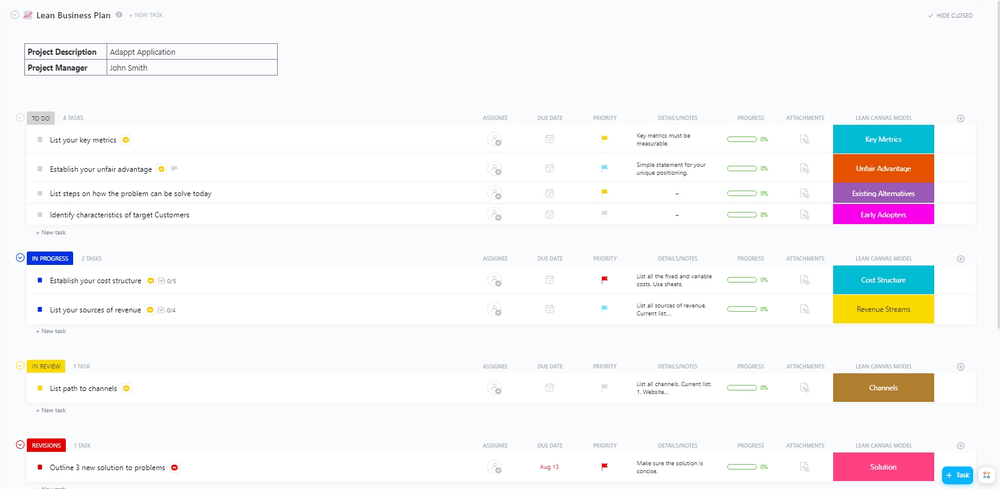
تم تصميم قالب خطة العمل المرنة من ClickUp لمساعدتك على تخطيط وتنفيذ استراتيجية عملك بفعالية.
/ctaBtn/الأخضر https://app.clickup.com/signup?template=t-200476485 تنزيل هذا القالب /%ctaBtntn/
إذا كنت حريصًا على تنفيذ هدف أو أكثر من الأهداف التي ناقشناها، فجرّب نموذج قالب المسار الوظيفي ClickUp للحفاظ على مركزية خطط التطوير الوظيفي الخاصة بك! إنه قابل للتخصيص بالكامل ومثالي للتخصيص بسرعة تخطيط عملياتك من الألف إلى الياء

حدد أهدافك المهنية وتصورها على لوحة بيضاء ملونة باستخدام قالب المسار الوظيفي ClickUp Career Path Template
/ctaBtn/الأخضر https://app.clickup.com/signup?template=t-194505180 قم بتنزيل هذا القالب /%ctaBtntn/
5 نصائح لتحديد أهداف هندسة البرمجيات وتحقيقها ## 5 نصائح لتحديد أهداف هندسة البرمجيات وتحقيقها
الآن بعد أن استكشفنا أهداف هندسة البرمجيات الناشئة، حان الوقت لوضع هذه الأهداف وتحقيقها. قد تبدو إدارة أهداف متعددة أو كبيرة الحجم إلى جانب مهامك المعتادة أمرًا مرهقًا، خاصةً بدون أدوات التنظيم لمساعدتك
لحسن الحظ انقر فوق -برنامج قوي متعدد الإمكانات حل إدارة المشاريع مثالي ل فرق البرمجيات -يوفر جميع الأدوات اللازمة لتحديد الأهداف ومراقبتها وتحقيقها بكفاءة.
من مساعد مدعوم بالذكاء الاصطناعي لتتبع خطط التطوير وتوليد خرائط طريق المنتج إلى مجالس أجايل وسكرم لإنشاء مهام سير عمل فريدة من نوعها، فإن ClickUp قد غطيت كل ما يخصك في إدارة المشاريع الهندسية المساعي 🙌
دعنا نتعمق في أهم خمس نصائح لتحديد الأهداف وتحقيقها بفعالية في حياتك المهنية في مجال هندسة البرمجيات!
1. نظّم أهدافك في منصة يسهل الوصول إليها
إن تنظيم أهدافك بشكل مركزي داخل منصة واحدة هو عامل مغير للعبة من أجل تنظيم أهدافك بكفاءة ووصول سلس إليها، ولتحقيق إدارة الأهداف بشكل ممتاز، يجب أن توفر المنصة التي تستخدمها جداول ولوحات رقمية متنوعة مزودة بحقول قابلة للتخصيص. لماذا؟ لأن هذه الأدوات تتيح لك تحديد المواعيد النهائية وتتبع التقدم المحرز وتدوين الملاحظات الأساسية دون عناء. ✅
عندما تتعامل مع أهداف كبيرة وطويلة الأمد، قسّمها إلى مهام صغيرة الحجم. لنفترض أنك تحلم ببدء مشروعك الخاص - قسّم هذا الحلم إلى خطوات قابلة للتنفيذ مثل الغوص في أبحاث السوق وصياغة منتجك، والسعي للحصول على التمويل، وتأمين البيع الأولي. القيام بذلك سيجعل تلك الأهداف الكبيرة التي تبدو مستحيلة التحقيق أكثر قابلية للتحقيق.
يمكنك القيام بكل هذا وأكثر مع أهداف النقر -اجعل أحلامك حقيقة واقعة من خلال وضع جداول زمنية واضحة وأهداف قابلة للقياس واستخدام أتمتة ClickUp لتتبع مدى تقدمك، كل ذلك من خلال منصة واحدة!
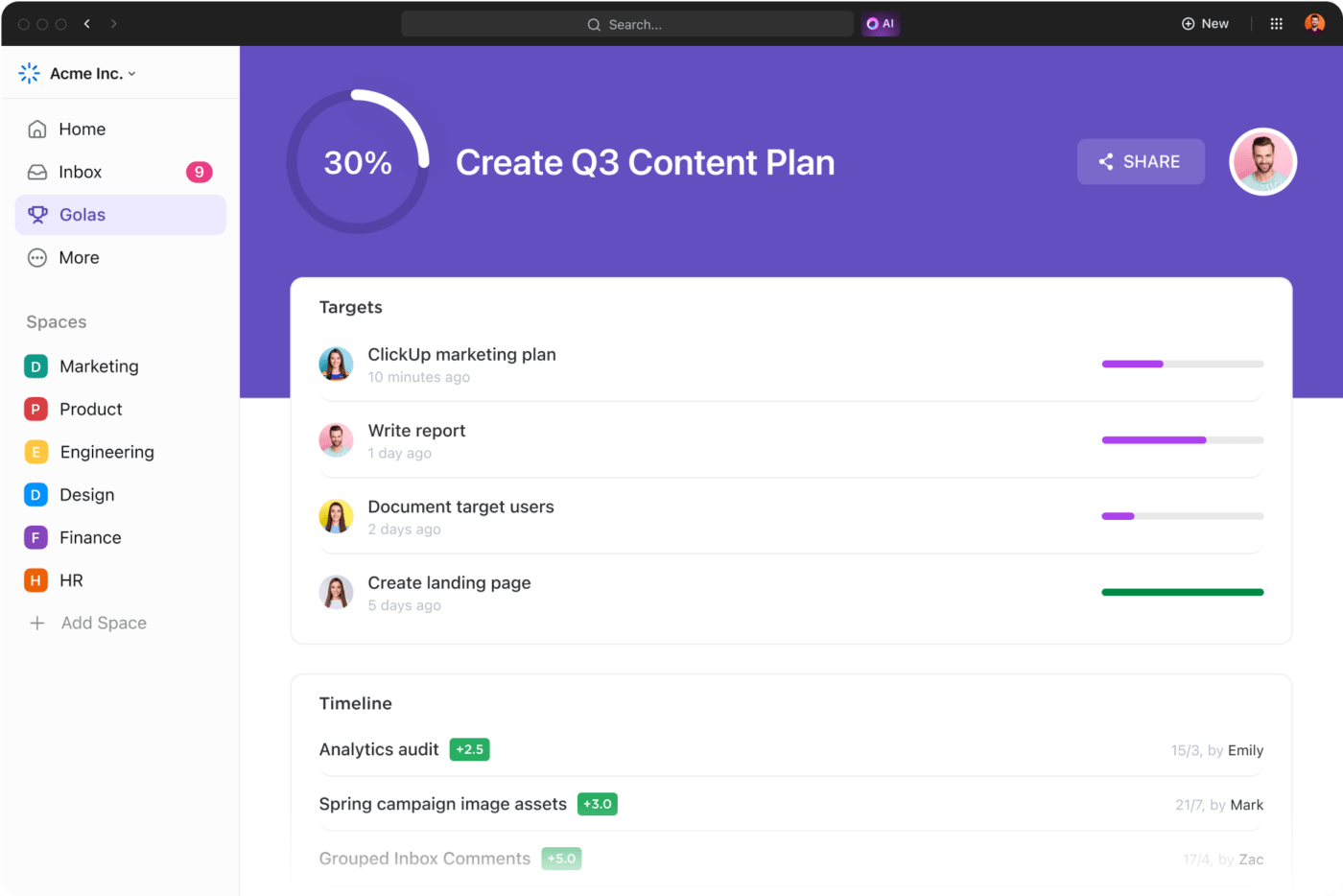
حدد جميع أهدافك ومعالمك ونظمها وتتبعها دون عناء مع ClickUp
حدِّد المراحل الحاسمة في رحلة تحديد أهدافك على النحو التالي المعالم الرئيسية وتقسيم الأهداف الرئيسية إلى أهداف يمكن التحكم فيها لزيادة الكفاءة. يتيح لك ClickUp:
- وضع أهداف رقمية
- استخدام أهداف صواب/خطأ للمهام "المكتملة" أو "غير المكتملة"
- استخدم الأهداف النقدية لمراقبة الأهداف المالية لـإدارة أفضل للميزانية
- حدد المهام الفردية كأهداف للأهداف المعقدة
الأهداف العددية تسمح لك بتتبع المهام التي يمكن تقسيمها إلى وحدات واضحة، مثل "إكمال 5 مسائل ترميز خلال أسبوع". الأهداف الصحيحة/الخاطئة، من ناحية أخرى، تعتبر الأهداف الصحيحة/الخاطئة رائعة لمراقبة إكمال مهام ترميز محددة، مثل التحقق مما إذا تم تنفيذ ميزة ما أو إصلاح خطأ ما. 🐞
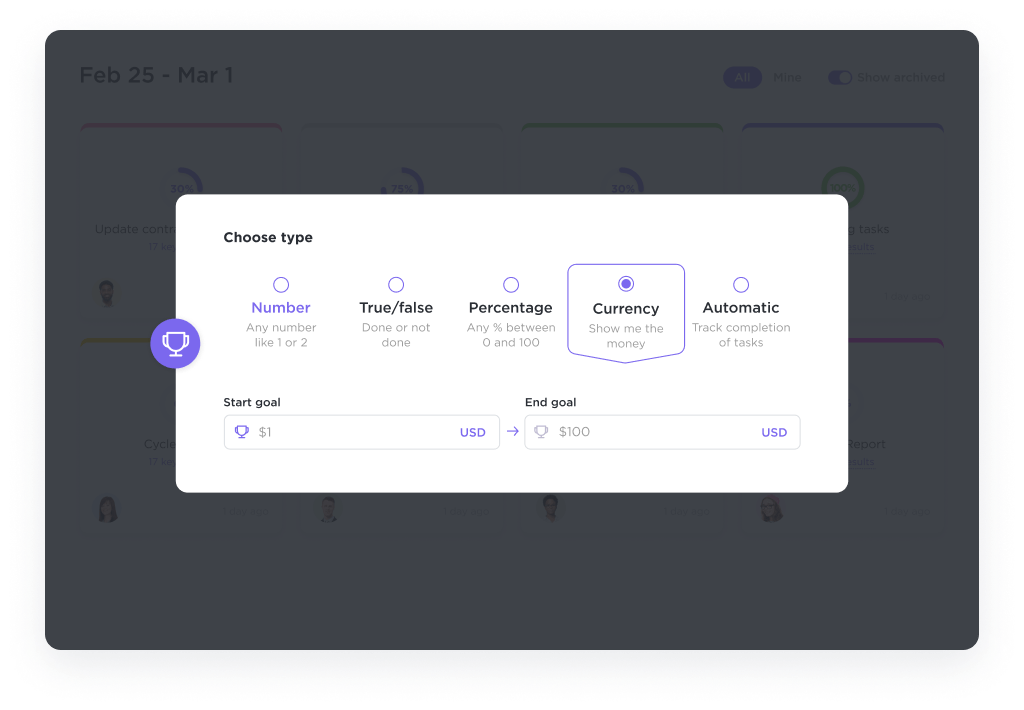
اختر من بين أنواع الأهداف المختلفة للقياس بالعملة والنسب المئوية والأرقام والصواب أو الخطأ
يمكنك أيضًا تنظيم الأهداف المترابطة في مجلدات، مما يوفر لك عرضًا سريعًا وشاملًا لتقدمك نحو الأهداف الشاملة.
2. حدد الأهداف ذات الأولوية القصوى
في السعي لتحقيق الأهداف، غالبًا ما يؤدي الشعور بالإرهاق إلى التخلي عنها تمامًا. يتطلب التعامل مع قائمة طويلة من التطلعات أو هدف ضخم مع عدد لا يحصى من الخطوات الأصغر حجمًا أسلوبًا مهمًا: تحديد الأولويات. ☝️
لنفترض أنك تتطلع إلى تحقيق أهدافك التقنية - تنفيذ مشروع بلغة جديدة، وإتقان التحكم في الإصدار، والتنقل في منصة سحابية. من المستحيل التعمق في هذه الأهداف الثلاثة في وقت واحد، لذا يصبح تحديد الأولويات أمرًا بالغ الأهمية.
ابدأ بإتقان التحكم في الإصدار - وهي مهارة أساسية قابلة للتطبيق عبر مختلف المشاريع واللغات. بعد ذلك، تعمّق في لغة أو إطار عمل جديد، ووسّع مجموعة مهاراتك. وأخيراً، ركز على تشغيل المشاريع على منصة سحابية، مستفيداً من الأفكار والمهارات المكتسبة من تحقيق الهدفين السابقين.
ClickUp أولويات المهام يوفر النظام هيكلًا من أربعة مستويات لتوجيه عملية اتخاذ القرار. على سبيل المثال، لنفترض أن هدفك الكبير هو تطوير ميزة جديدة لتطبيق ما. استخدم هذا النظام لتصنيف المهام على النحو التالي:
- عاجل: اهتمام فوري (إصلاح الأخطاء الحرجة التي تؤثر على تجربة المستخدم)
- عالية: مهام مهمة تتطلب إنجازًا سريعًا (تصميم البنية الأساسية للميزة)
- عادي: مهام مهمة ولكن أقل حساسية للوقت (تنفيذ عناصر واجهة المستخدم)
- منخفضة: المهام الأقل أولوية أو الأقل حساسية للوقت (تحسين أداء الميزة)

تعيين الأولويات من خلال تحديد مستويات الاستعجال لكل مهمة في ClickUp
تعيين علامات الأولوية بسيط - ما عليك سوى النقر على أيقونة العلم واختيار مستوى الاستعجال من القائمة المنسدلة. تمثل العلامات الحمراء المهام العاجلة، وتُستخدم العلامات باللون الرمادي الفاتح للمهام الأقل أهمية، مما يضمن سرعة تحديدها. 🚩
3. شارك أهدافك مع زملائك ومشرفيك
يمكن لزملائك من مهندسي البرمجيات أن يكونوا متحمسين لتطلعاتك المهنية مثلك تماماً. إن مشاركة أهدافك معهم تفتح حواراً يتيح لكلا الطرفين تتبع التقدم المحرز والاحتفال بالإنجازات معاً. بالإضافة إلى ذلك، فإن إبقاء الأصدقاء والزملاء على اطلاع دائم يعني وجود شركاء للمساءلة يشجعونك ويبقيك على المسار الصحيح نحو أهداف المشروع . 🥳
وعلاوة على ذلك، غالبًا ما يحب المشرفون رؤية أعضاء فريقهم متحمسين لنموهم. عندما تتحدث عن أهدافك مع مشرفك، فهي ليست مجرد محادثة - بل هي فرصة، فقد يعرضون عليك موارد مثل التدريب المتخصص أو المزيد من الاستقلالية في المشاريع. وهذا يعرض مبادرتك، مما قد يؤدي إلى مسؤوليات أو مكافآت إضافية.
مع ClickUp، أصبحت لعبة مشاركة الأهداف أسهل من أي وقت مضى. سواء كنت نظمت أهدافك في قالب مُعد مسبقًا أو إنشائها من الصفر، يمكنك مشاركة القوائم أو اللوحات أو المستندات مع الزملاء أو المشرفين دون عناء باستخدام الروابط القابلة للمشاركة وعناصر التحكم في الوصول.
لنفترض أنك تستخدم قالب الهدف السنوي لـ ClickUp لتجميع الأهداف والغايات للسنة القادمة. يمكنك دعوة الآخرين ليس فقط للاطلاع عليها ولكن أيضًا للتعليق مباشرة على المستند المشترك! مستندات ClickUp صنع التعاون في الوقت الحقيقي بسهولة، مما يسمح للفرق بالتحرير، وتعيين المهام، ووضع علامات على الأعضاء، وتحويل النص بسلاسة إلى خطوات قابلة للتنفيذ، مما يحافظ على تنظيم كل شيء وفعاليته. ✨
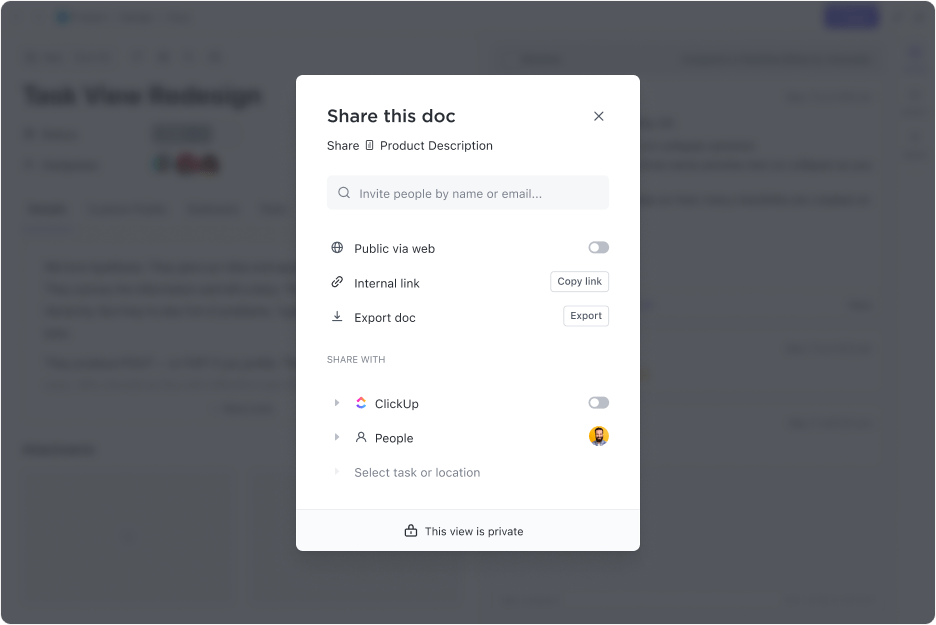
التعاون هو المفتاح مع ClickUp 3.0 Docs حتى تتمكن من المشاركة أو تعيين الأذونات أو التصدير بسرعة إلى المستخدمين الداخليين أو الخارجيين
هذا يعني أيضًا أن مناقشة أهدافك مع مشرفك تصبح طريقًا ذا اتجاهين. يمكنهم تقديم اقتراحات من خلال إسقاط التعليقات مباشرةً على مستندك المشترك، والتي يمكنك مراجعتها وتنفيذها حسب الحاجة.
4. حدد مواعيد نهائية لإنجاز الأهداف
يعد تنفيذ المواعيد النهائية لأهدافك عاملاً مغيراً لقواعد اللعبة في ضمان الإنجاز في الوقت المناسب. ابدأ بوضع جداول زمنية واقعية لكل هدف. وبعد انقضاء المدة المحددة، قم بتقييم التقدم الذي أحرزته بشكل نقدي - فهذا التفكير أمر حيوي في قياس ما إذا كانت المواعيد النهائية التي حددتها ممكنة التنفيذ، ويساعد على ضبط المواعيد النهائية المستقبلية.
ضع في اعتبارك أن المواعيد النهائية ليست ثابتة. طوال فترة سعيك لتحقيق هدفك، قم بتقييم هذه المواعيد النهائية بانتظام. هل أنت على المسار الصحيح، أم أنك بحاجة إلى إجراء تعديلات؟ المرونة أمر بالغ الأهمية للحفاظ على واقعية جدولك الزمني وقابليته للتحقيق.
مع عرض تقويم ClickUp يمكنك تتبع تواريخ الاستحقاق و تعيين التذكيرات حتى لا يفوتك أي شيء. إنه متعدد الاستخدامات، حيث يقدم عروضًا يومية أو أسبوعية أو شهرية حتى تتمكن من مراقبة جميع مواعيدك النهائية بسهولة. 📅
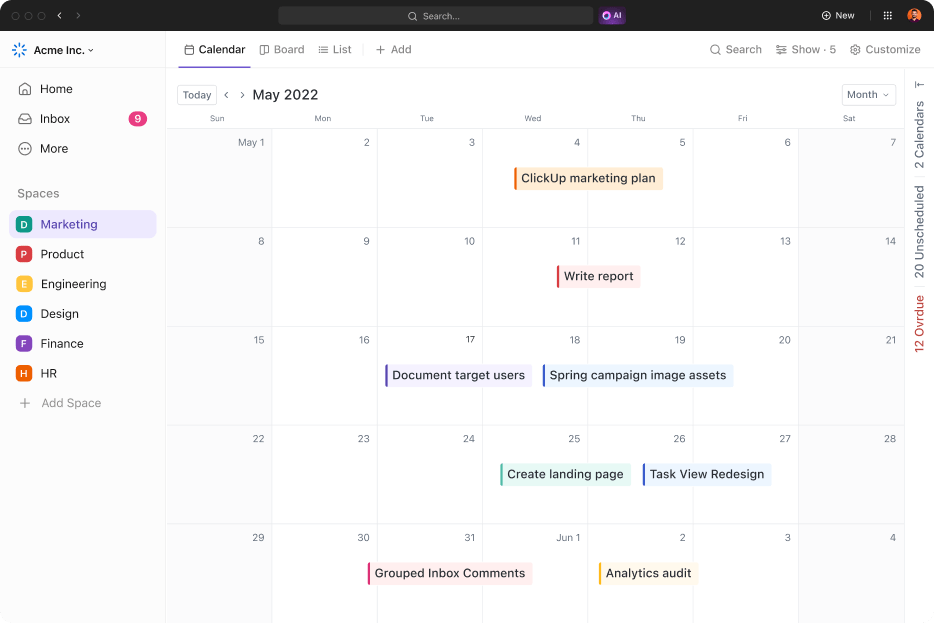
إدارة المشاريع وتنظيمها، وجدولة المهام عبر طريقة عرض التقويم المرنة للحفاظ على مزامنة الفرق
الجدولة سهلة للغاية - اسحب المهام وأفلتها في التقويم الخاص بك، وها هي! تضيف المهام المرمزة بالألوان طبقة من التنظيم، مما يساعدك على الفرز حسب المشروع أو الأولوية أو الحقول المخصصة.
قم بالتصغير للحصول على نظرة عامة واسعة للمشروع أو قم بالتكبير للحصول على تفاصيل المهام. اعتمد على الفلاتر لتحسين طريقة العرض، مع تسليط الضوء على المهام المهمة حقًا. يمكنك حتى مشاركة التقويم الخاص بك أو بدء الاجتماعات مباشرةً من طريقة عرض التقويم، مما يجعل التنسيق جزءًا سلسًا من جدولك الزمني.
5. مراجعة التقدم المحرز وتكييف الأهداف بانتظام
قم بتقييم تقدمك باستمرار وكن مستعداً لتكييف أهدافك عند الحاجة. نظرًا لتقلب الظروف، قد تتطلب الأهداف تعديلها. ابقَ قابلًا للتكيف ومستعدًا لتعديل الأولويات. على سبيل المثال، بمجرد أن تصبح مهاراتك التقنية قوية، فكر في تحويل التركيز إلى الأهداف الشخصية أو أهداف التواصل. 🤝
الاستفادة من لوحات معلومات ClickUp للحصول على لقطة مرئية لتقدمك، مصممة حسب تفضيلاتك - سواء من خلال المخططات الدائرية أو الخطية أو الشريطية.
وباستخدام أدوات مثل الرسوم البيانية الدائرية والمخططات الخطية والمخططات الخطية، يمكنك تتبع أدائك مقابل الأهداف المحددة وإجراء التوقعات والتنبؤات. يتيح لك هذا العرض الشامل مراقبة الأهداف، واكتساب رؤى قيّمة حول تقدمك، وإجراء التعديلات اللازمة بسلاسة على طول الطريق.
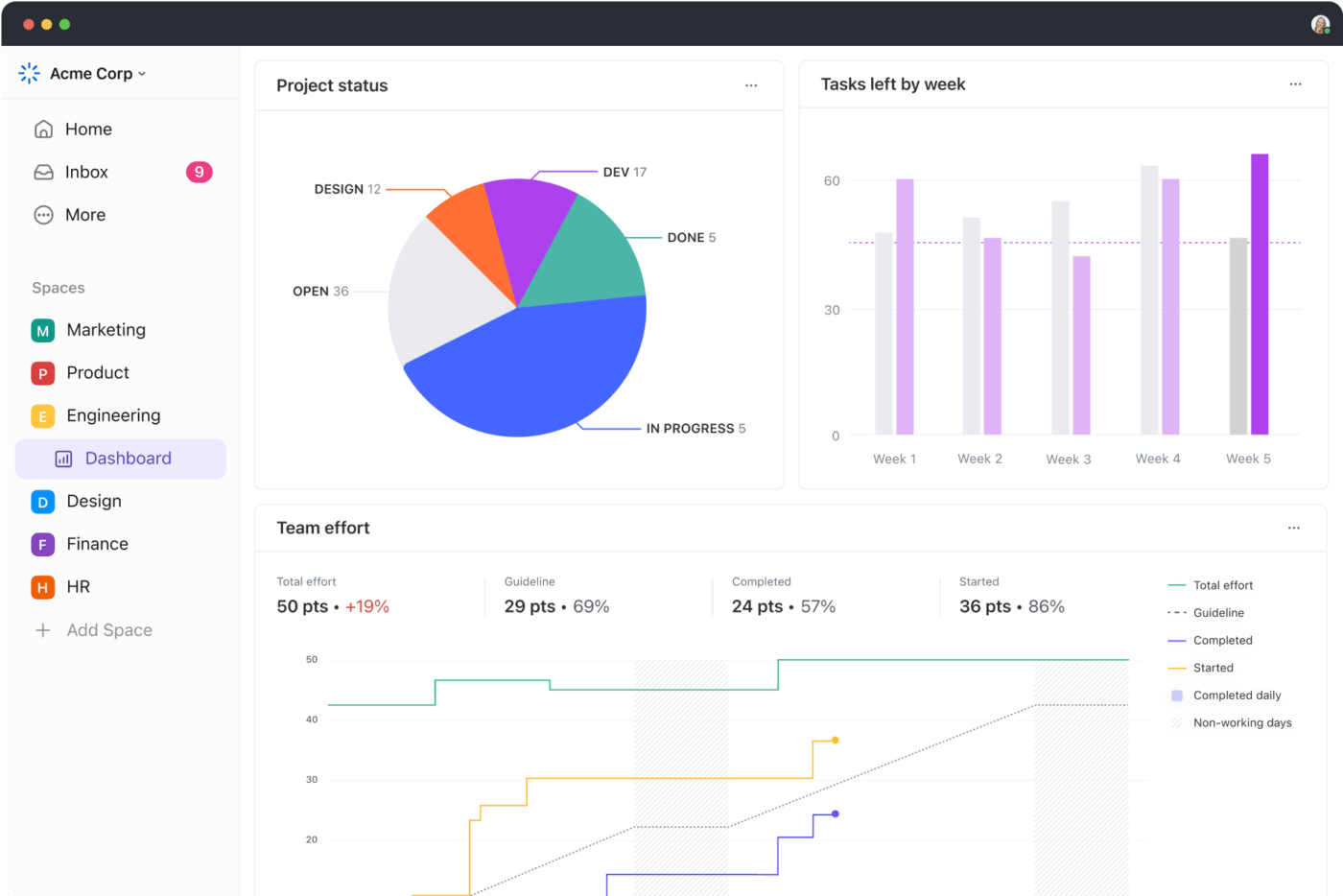
احصل على عرض شامل لحالات المشاريع والمهام المتبقية في فريقك أو قسمك باستخدام لوحات المعلومات في ClickUp 3.0
انتقل إلى أهداف هندسة البرمجيات بسهولة باستخدام ClickUp
تُعد صياغة أهداف ذكية (وذكية) لمهندسي البرمجيات وتحقيقها بكفاءة أمرًا بالغ الأهمية للتقدم في حياتك المهنية. من خلال تبني نصائحنا العملية والاستفادة من أدوات تحديد الأهداف الصحيحة، ستتمكن من تحقيق تطلعاتك المهنية والشخصية والتقنية! انضم إلى ClickUp مجانًا اليوم واستفد من مجموعة أدوات إدارة العمليات والمبنية مسبقًا قوالب هندسة البرمجيات لتحديد أهدافك وتحقيقها كالمحترفين! 😎

